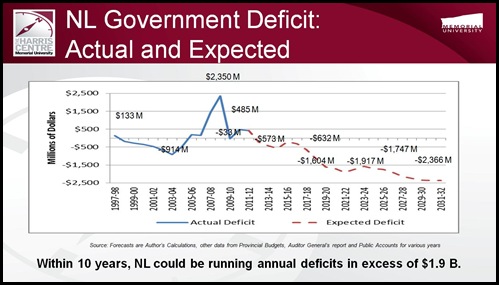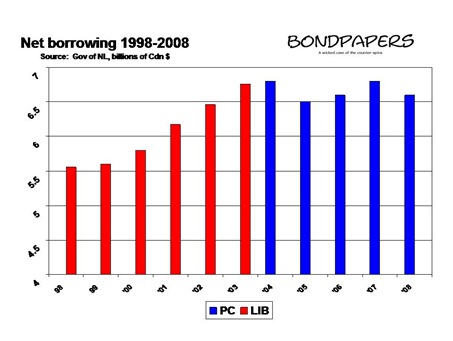In Budget 2009, we invested $2.6 billion in health and community services. This is no doubt a significant amount. This represents a billion dollar increase in the past five years. While we would like to do everything and meet every demand, that investment is simply unsustainable.
Paul Oram, Minister of Health and Community Services, September 21, 2009 [video file]
Note the date.
Health minister Paul Oram admitted today that the provincial government’s financial management since 2003 has produced a level of government spending that is - in his words - “unsustainable.”
That is not just Paul Oram’s word.
His remarks were approved at the highest level.
That word - unsustainable - is the word that the Premier’s Office chose to describe the financial state of the provincial government.
Until now, the Williams administration has prided itself on exactly the opposite. This is a remarkable admission for the Williams administration, an administration that has prided itself on what it claimed was sound management of the public treasury.
Regular readers of Bond Papers have known it for some time.
The earliest use of the word “unsustainable” in connection with provincial government spending was
2006:
What no one knew was that oil would hit US$70 a barrel and the cash would be pouring in at a rate no one in the province had ever seen before. That allowed Danny Williams to avoid making a whole bunch of good decisions and to crank up spending to unprecedented and, and in light of the economic slowdowns, likely unsustainable, heights.
The word turned up again a few months later in a quick look at the 2007 budget:
The current and forecast spending increases are based on optimistic projections for the price of oil in the medium term. Any downward trend in commodity prices (oil, minerals etc) will quickly make the consistent spending increases since 2003 unsustainable. Fiscal reality in those circumstances - taking less money in than is flowing out - would require program cuts, job losses and/or tax increases to correct.
Take a second and go read that post. You’ll find the “unsustainable” again:
That level of per capita spending [second only to Alberta] is unsustainable in the long run. As a recent Atlantic Institute for Market Studies assessment concluded:
“If the province fails to reign in its whopping per capita government spending (about $8800/person [in FY 2006]) and super-size me civil service (96 provincial government employees /1000 people) it will quickly erode any gains from increased energy revenues.”
That is exactly the situation Paul Oram described today.
Look through Bond Papers and you will see repeated warnings about the unsustainable growth in government spending since 2004/05.
This is not an exercise in “I-told-you-so”; let’s clear that out of the way at the start.
This is about something much more significant.
Point One: The issues are not new and the implications of the issues aren’t new.
Go back further than 2006.
Go back to the early to mid 1990s and you will see forecasts that showed the demographics in the province for the time period we are currently in and that mapped out the implications for health care costs. Some of those same ideas turned up here in several posts throughout 2007 and 2008 that discussed the very serious financial state facing the provincial government.
Point Two: Fail to plan; plan to fail.
The current situation is a direct result of a series of short-term decisions made by the current administration since 2003. The short-term spending decisions took place in every aspect of spending; health care just happens to be the one place in the budget where the demand for more spending is greatest and where the implications of spending are also proportionately great..
How do we know the decisions have been made on an ad hoc basis?
Well, the indicators are littered throughout the correspondence released today by the provincial government.
For starters, just look at the dates on the e-mails to the regions. The provincial government only settled on its spending allocations in late February and even then, the decisions were preliminary.
Since 2003, the budget process has slipped further and further back in time such that crucial decisions – like gross spending – are not made until a few weeks before the end of the fiscal year. The reality of these letters suggests that budget decisions were not made until well into the current fiscal year.
Throughout the 1990s and into the early part of this century, the big picture spending decisions were made before Christmas. By the time late February rolled around, the individual line items had been settled such that there was very little to decide. In those days, the only adjustments that came after February would be cuts based on any changes to federal spending.
But in a provincial government where cash hasn’t been an issue, there is really no reason why the annual budget process should be so far out of whack that major budget decisions are still not settled four weeks before the end of the fiscal year.
Secondly, notice that the direction from the department to the regions is simply to freeze spending at 2008 levels. That’s a short-term decision if ever there was one, not the sign of a decision taken within the context of a longer-term plan.
Thirdly, take a look at the list of options offered up by the boards. In Central, there is a wide and unconnected list. On the one hand there are major program shifts. On the other, there is an inconsequential cancellation of a single position for a few thousand dollars. In Western, the increased costs forecast include substantial amounts that have to be annualised. That is, the initial amounts increase over time as with any program spending.
None of this is a sign of planning either at the regional or provincial level. Rather it suggests a series of ad hoc decisions being made in response to ad hoc direction from central authorities. As can be seen particularly in the letter from Western region and Labrador-Grenfell, significant new projects were started in 2007 and 2008 which need to be continued. Yet, in preparing for 2009, the long-term implications of these projects are called into question by a predicted downturn in the economy.
In truth, this inconsistent management situation matches up with what we have seen from the provincial government across the board. Capital works projects take inordinately long times to get start. Significant legislative measures get lost for upwards of two years and more before they are implemented. All the delays cost money.
Point Three: The solution cannot be more of the same.
One of the most obvious implications of analysis done for the Strategic Social Plan approved by cabinet in December 1995 was that government needed to fundamentally change how it delivered some services if it was going to balance the demand with the ability to supply.
Unfortunately, one of the first acts of the Tobin administration in 1996 was to scrap the SSP and replace it with a pale imitation. Gone were the needed reforms. What has occurred since 2003 has been a continuation of the situation post-1996, with predictable results. Until now, the Williams administration has steadfastly refused to acknowledge it faced a very serious problem.
But acknowledging that a problem exists is the first step to setting things right.
With all that as the basis, the next few posts will lay out some ideas for producing fundamental changes aimed at providing a financially sound future for the province.
-srbp-





